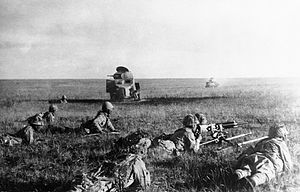ยุทธการที่ฮาลฮิน กอล ส่วนหนึ่งของ ข้อพิพาทชายแดนโซเวียต–ญี่ปุ่น วันที่ 11 พฤษภาคม – 15 กันยายน ค.ศ. 1939 สถานที่ ผล
โซเวียตและมองโกเลียชนะ
การโจมตีของญี่ปุ่นได้หยุดชะงัก
ได้มีการลงนามข้อตกลงสงบศึก ดินแดน
สถานะเดิมก่อนสงคราม; บังคับใช้สิทธิบนชายแดนตามข้อตกลงของโซเวียตและมองโกเลีย
คู่สงคราม
สหภาพโซเวียต สาธารณรัฐประชาชนมองโกเลีย
ญี่ปุ่น ประเทศแมนจูกัว ผู้บังคับบัญชาและผู้นำ
กำลัง
61,860–73,961 [ nb 1] armored cars [ 4] [ 5]
500[ 7] [ 2] [ 8] [ 9]
30,000 [ 10] [ 11] 38,000 [ 12] [ 5] tankettes
~300 artillery pieces[ 2] [ 13] [ 14] ความสูญเสีย
Manpower: [ nb 2] [ 16] [ 2] Equipment: [ 17] [ 18] [ 15] [ 16] [ 19]
Manpower: [ nb 3] Equipment: [ 17] [ 5] [ 21] [ 14] [ 22]
ยุทธการฮาลฮิน กอล เป็นการสู้รบอย่างดุเดือดของข้อพิพาทชายแดนโซเวียต–ญี่ปุ่น โดยไม่ได้ประกาศซึ่งสู้รบบนพื้นที่ระหว่างสหภาพโซเวียต , มองโกเลีย , ญี่ปุ่น และแมนจูกัว ในปี ค.ศ. 1939 ชื่อของความขัดแย้งครั้งนี้มาจากแม่น้ำฮาลฮิน กอล ซึ่งได้เคลื่อนทัพผ่านสนามรบ ในญี่ปุ่น,การสู้รบอย่างดุเดือดของความขัดแย้งนี้ยังได้เป็นที่รู้จักกันในชื่อ เหตุการณ์โนะมอนฮาน (ノモンハン事件 Nomonhan jiken) จากหมู่บ้านบนบริเวณชายแดนระหว่างมองโกเลีย และแมนจูเรีย ผลลัพธ์ของการรบครั้งนี้คือความพ่ายแพ้ของกองทัพญี่ปุ่นที่ 6
↑ Kotelnikov p. 109 (2002)
↑ 2.0 2.1 2.2 2.3 Khalkhin Gol Battle: the Revision of Statistics. เก็บถาวร 2015-08-22 ที่ เวย์แบ็กแมชชีน Retrieved 21 June 2015.↑ [1] Retrieved 15 Oct. 2015.↑ "The Chief Culprit" , by Viktor Suvorov,↑ 5.0 5.1 5.2 Zaloga, p. 13.
↑ 6.0 6.1 V. Kondratiev, "Khalkhin Gol: War in the Air" retrieved 3 Jan. 2016↑ "The Chief Culprit" , by Viktor Suvorov, p.[ต้องการเลขหน้า .↑ Coox, p. 580
↑ "The Khalkhin Gol Battle, 1939" Retrieved 3 Jan. 2016↑ Bellamy and Lahnstein (1990) The New Soviet Defensive Policy: Khalkhin Gol 1939 as Case Study เก็บถาวร 2016-12-11 ที่ เวย์แบ็กแมชชีน p. 24
↑ The cited source here describes Japanese forces after the assault on the Soviets as numbering 28,000 men, and includes Manchukuoan forces. For more information, see the "Aftermath" section.
↑ "Áèîãðàôèÿ Ãðèãîðèé Øòåðí" . สืบค้นเมื่อ 4 March 2015 .↑ Coox, p. 563
↑ 14.0 14.1 Coox, p. 1168
↑ 15.0 15.1 M. Kolomiets "Boi u reki Khalkhin-Gol" Frontovaya Illyustratsia (2002)
↑ 16.0 16.1 Soviet Losses in the Khalkhin Gol Battle. Retrieved 21 July 2015.↑ 17.0 17.1 Кондратьев В. Халхин-Гол: Война в воздухе. — М.: Библиотека журнала "Техники – Молодежи". Серия "Авиация", 2002. — 64 с. Тираж 1000 экз.ISBN 5-88573-009-1 .
↑ According to "Soviet Losses in the Khalkhin Gol Battle" , these losses break down as: 30 BT-7s , 27 BT-7RTs,2 BT-7As, 127 BT-5s , 30 BT-5RTs, 8 T-26s , 10 KhT-26 S, 2 KhT-130 S, and 17 T-37s . This does not include tanks that only sustained light to moderate damage, or ones lost due to mechanical failure.
↑ Coox, p. 576. During one Japanese counterattack alone on the 12/13th of August the MPR 8th cavalry division lost 100 horses captured
↑ Glantz, David M.; and House, Jonathan. When Titans Clashed: How the Red Army Stopped Hitler . Lawrence, KS: UP of Kansas, 1995. ISBN 0-7006-0899-0 p. 14.
↑ Coox, p. 987. Includes 28 120mm–150mm guns and 44 75mm guns.
↑ Coox, "Nomonhan: Japan against Russia" There are multiple accounts of Japanese trucks being knocked out by Soviet artillery and aviation, as well as losses due to mechanical failures or environmental hazards.
อ้างอิงผิดพลาด: มีป้ายระบุ <ref> สำหรับกลุ่มชื่อ "nb" แต่ไม่พบป้ายระบุ <references group="nb"/> ที่สอดคล้องกัน
